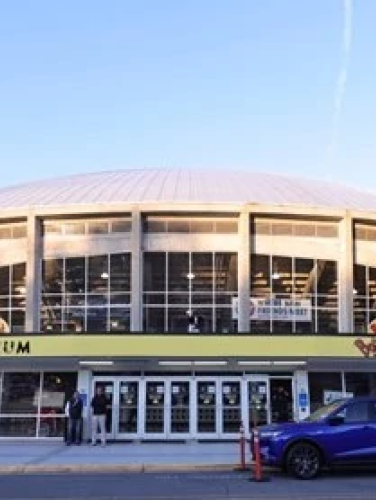
Charlotte Coliseum
(ca. 1955)
Since its opening in 1955, the uniquely Modernist styled Charlotte Coliseum has been entertaining Charlotteans for more than half a century.
2700 E Independence Blvd, Charlotte, NC 28205
Prior to the 1955 opening of the Charlotte Coliseum as the area’s first single-purpose sports facility, the premier local indoor entertaiment venue was the Charlotte Auditorium and Armory, a 1929 facility built in only seventy-three working days to host the thirty-ninth reunion of Confederate Army veterans. That outdated facility, once located at 310 North Kings Drive (it burned in 1954), had become so inadequate that it struggled to attract quality entertainment. When completed, the new coliseum was large enough to fit the entire Charlotte Auditorium and Armory on its main arena floor.
Property Quick Links
The Charlotte Coliseum was some fifteen years in the making. Local advocates began calling for such a facility in the early 1930s, but World War II delayed any such plan. A 1947 $2.5 million bond referendum for a municipal auditorium and civic center was roundly defeated primarily because no plans for the facility – not even draft renderings or a proposed location – accompanied the proposal. In 1949, Charlotte Mayor Victor Shaw tried again, launching a behind-the-scenes campaign to build a city auditorium adjacent to the Oasis Tempe of the Shrine on South Tryon Street. Once public, that effort also failed. Later that year, Shaw created a planning committee, headed by J.B. Ivey & Company Vice President and General Manager David Ovens, to reinvigorate the proect.
The Ovens Committee selected A. G. Odell to design a coliseum and an auditorium. A native of Concord, North Carolina, Odell studied civil engineering at Duke University and architecture at Cornell University before matriculating at the L’Ecole des Beaux Arts in Paris. He moved to Charlotte in 1939 to open a one-man office that eventually grew into one of North Carolina’s most influential architectural firms. Site selection proved problematic until the committee secured an Independence Boulevard parcel large enough for a 10,000-seat coliseum with adequate parking and far enough from uptown to prevent traffic congestion. A $3 million bond referendum for the project passed in 1950, but federal government controls on steel consumption (due to the Korean War and a 1949 steelworkers strike) and intervening cost increases soon stalled construction. Even when work finally began in 1953, challenges continued: rising costs necessitated another bond referendum, and the combination of a sheet metal workers strike, high winds, and bad weather delayed completion until mid-1955.
Upon opening, the circular Modernist coliseum was the largest free-span dome in the world. It received international acclaim. Some 1,000 tons of steel went into construction of the 12,500-seat capacity arena. Its dome – spanning 332 feet, four inches and supported by inward-leaning concrete columns joined by a tension ring – necessitated the use of a new architectural innovation: a computer to complete the complex calculations required for the structural challenges of such a building. Those years of planning and work ultimately paid off, as the Charlotte Coliseum became the region’s premier sports and entertainment venue hosting a wide range of performers (including Elvis Presley, David Bowie, Jimi Hendrix, the Beach Boys, Elton John, Bob Dylan, the Jackson 5, Buddy Holly, Bruce Springsteen, Judy Garland, Johnny Cash, Little Richard, the Eagles, Prince, the Osmonds, Queen, the Rolling Stones, Tina Turner, Sonny and Cher, KISS, and Billy Graham) and everything from basketball, hockey, and arena football to roller derby and professional wrestling.

